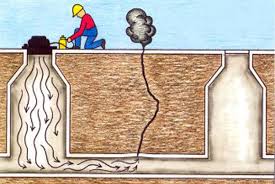1. What is smoke-testing and why is it happening?
Smoke-testing is a standard method of confirming and identifying connections to the sanitary sewer system and identifying improper connections and defects. We are undertaking this testing to track storm “inflow and infiltration” (or “I & I”). I & I introduces a significant amount of extra water to the wastewater treatment plant (WWTP) which uses capacity at the plant and costs money to treat. During significant rainfall, flows to the WWTP can easily double, making flows at the plant very difficult to manage.
2. How does smoke-testing work?
Smoke-testing consists of forcing a non-toxic fog, similar to that used in theatrical productions, into sewer manholes. The field crews then monitor where the smoke escapes. If smoke permeates up through the ground, it indicates a break in the sanitary line where groundwater can enter. If it exits via gutters or downspouts, then a storm service connection is incorrectly connected to the sanitary system.

3. Is the smoke dangerous in any way?
No. The “smoke” is specifically manufactured for this purpose. It leaves no residuals or stains on clothing, draperies or furniture and is not harmful to humans, plants or animals. Some people may find the smoke irritating to nasal passages. Individuals with respiratory concerns may contact the Town for specific testing times.
4. Will smoke enter my home during the testing?
Probably not. Smoke should not enter your building unless you have defective, damaged or improper plumbing OR if you have infrequently used drains that have dried out over time. Drains in your house have a P-Trap, which provides a water barrier to sanitary odours. If you have a sink or floor drain that is not used regularly, the water in the P-Trap can evaporate over time.
5. Is there anything I should do in advance of the testing?
Yes. To avoid smoke entering your building unnecessarily, we advise you to run water into all drains, including floor drains located near hot water tanks or in basements, for at least 30 seconds. This will fill the P-Trap with water, which will create a barrier and prevent the smoke from entering the building via your drains. *The water in the trap will remain effective for several months.*
6. What should I do if smoke enters my house?
The smoke should dissipate in about 20 minutes. As an added precaution, you may leave some windows open for ventilation purposes during the testing. If smoke appears in your home, it is likely that harmful sewer gases have been entering the building for some time. Please note the location of the leak and contact the field crews at 1.604.841.5468. While the Town of Gibsons will render all help possible, the correction of any defects in pipes and sewers on private property is the responsibility of the property owner.
*If there is smoke in your home and you are not sure if it is due to these tests, please call 911.*
To prevent false alarms, the Gibsons Volunteer Regional District Fire Department is notified of any smoke-testing work.
7. Is there anything else I should know?
It may be necessary for field crews to enter your property during the testing, but there is no need for them to enter your home, unless you have detected smoke and want them to identify the source of the leak. You do not need to be at home when the testing is underway.
Smoke-testing is an important part of keeping the Town’s sanitary system running efficiently and in an environmentally friendly manner. We appreciate your understanding and patience as we conduct this maintenance work.
CONTACT INFORMATION
In case of smoke inside your building during the tests, please contact us at 604-886-2274

